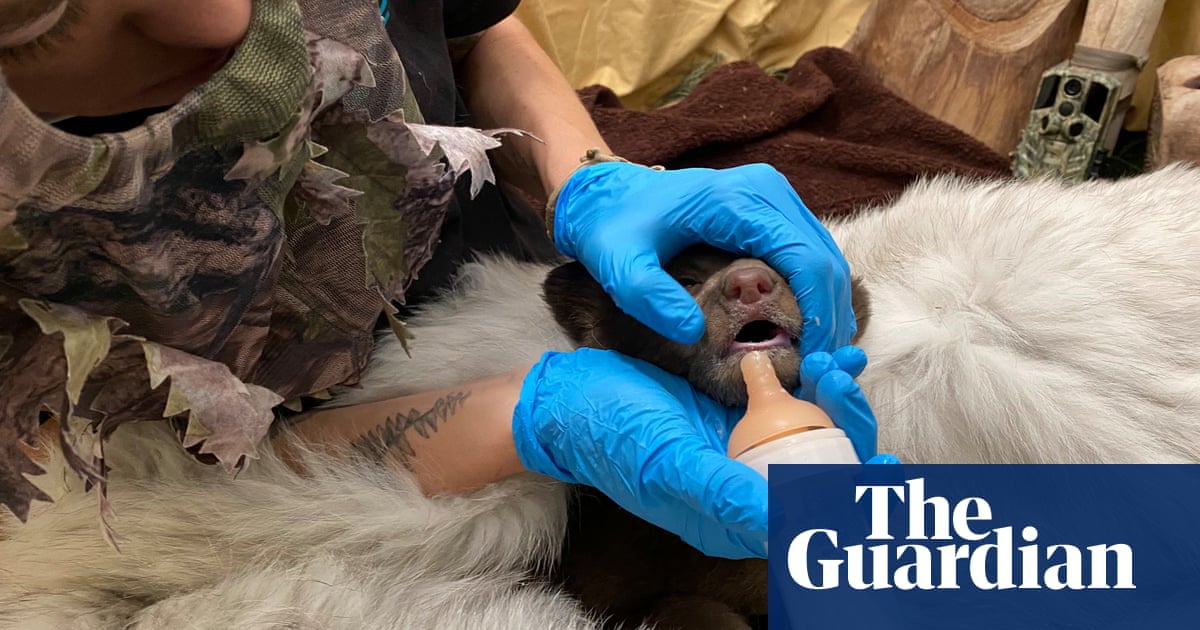Human bears, some would say, are taking care of a two-month-old cub that spent days without his mother, starving in aCaliforniaforest.
The small black bear cub was rescued by campers in Los Padres national forest after being found alone and starving. The infant bear is now recovering at San Diego Humane Society’s RamonaWildlifeCenter, and is believed to be the youngest cub the organization has ever cared for.
The two-month-old cub was discovered on 12 April by campers hiking in the forest. Wildlife officials with theCaliforniadepartment of fish and wildlife (CDFW) attempted to reunite him with his mother overnight, but she didn’t return. The cub was transferred to the Ramona facility two days later.
“The cub is thriving here. When he first arrived, he was only 3lbs and was a little debilitated, probably from going multiple days without any kind of nutrition or hydration,” said Autumn Welch, wildlife operations manager at the center. “He’s now quadrupled in size, he’s over 12lbs.”
Now thriving after more than a month of around-the-clock care, the cub is expected to remain at the center for up to a year. Staff are using enrichment sessions that mimic maternal behavior to prepare him for a future return to the wild, including staff members dressed as bears, plush toys and camouflaged headsets.
Welch said that keeping bears away from human interaction when they are young is key to avoiding conflicts in the future, once they’re released in the wild.
“They’re really smart and very food motivated,” Welch said. “As we continue to develop in the areas they live, they’re always being pushed into areas where people may have some type of conflict with them.
“Sometimes bears will get into trashes or get into people’s yards,” she added. “The more we can keep this cub wild and keep him from recognizing humans as the providers of anything good, we’re hoping every time we go in there, he’s seeing us as other bears and being able to identify with us as bears instead of humans.”
Officials say he could eventually be paired with another orphaned cub to help his development and minimize human imprinting.
Welch said the CDFW determines the site of where any of the bear cubs and rehabs go after they are released into the wild. The department takes into consideration a number of factors, such as where the bear was found, what the population is like in that area, if there’s any human wildlife conflict, and whether the site will provide for their nutrition needs.
She estimates the recently found cub won’t be released until the end of next spring or early summer.
Sign up toHeadlines US
Get the most important US headlines and highlights emailed direct to you every morning
after newsletter promotion
“At that point, they’ve grown quite a bit,” Welch said. “They’re usually around 130 to 150lbs and they get fitted with the GPS collar because the government biologists track them and see where their movements are and what they’re doing for a whole year after release.”
CDFW said this is only the fourth bear cub this young to enter rehab care in California in the past five years.
Raising such a young animal, Welch said, requires extensive time, expertise and funding – none of which comes from the state. The San Diego Humane Society relies solely on donations to sustain its wildlife rehabilitation efforts.
The Ramona Wildlife Center is the only facility in San Diego county permitted to rehabilitate native apex predators, including black bears, mountain lions and bobcats.
“This is a very unusual case,” Welch said in a press release. “We don’t often see bears this young without their mother. It’s an honor to care for him, but it’s also a significant commitment.”
